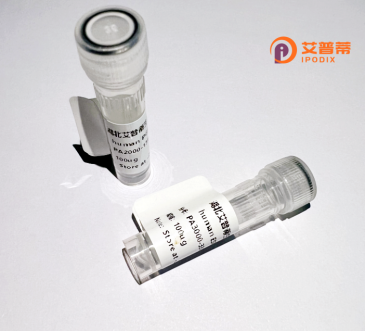
| 纯度 | >90%SDS-PAGE. |
| 种属 | Human |
| 靶点 | PRR7 |
| Uniprot No | Q8TB68 |
| 内毒素 | < 0.01EU/μg |
| 表达宿主 | E.coli |
| 表达区间 | 1-274 aa |
| 活性数据 | MVMSQGTYTFLTCFAGFWLIWGLIVLLCCFCSFLRRRLKRRQEERLREQNLRALELEPLELEGSLAGSPPGLAPPQPPPHRSRLEAPAHAHSHPHVHVHPLLHHGPAQPHAHAHPHPHHHALPHPPPTHLSVPPRPWSYPRQAESDMSKPPCYEEAVLMAEPPPPYSEVLTDTRGLYRKIVTPFLSRRDSAEKQEQPPPSYKPLFLDRGYTSALHLPSAPRPAPPCPALCLQADRGRRVFPSWTDSELSSREPLEHGAWRLPVSIPLFGRTTAV |
| 分子量 | 57.3 kDa |
| 蛋白标签 | GST-tag at N-terminal |
| 缓冲液 | PBS, pH7.4, containing 0.01% SKL, 1mM DTT, 5% Trehalose and Proclin300. |
| 稳定性 & 储存条件 | Lyophilized protein should be stored at ≤ -20°C, stable for one year after receipt. Reconstituted protein solution can be stored at 2-8°C for 2-7 days. Aliquots of reconstituted samples are stable at ≤ -20°C for 3 months. |
| 复溶 | Always centrifuge tubes before opening.Do not mix by vortex or pipetting. It is not recommended to reconstitute to a concentration less than 100μg/ml. Dissolve the lyophilized protein in distilled water. Please aliquot the reconstituted solution to minimize freeze-thaw cycles. |
以下是关于重组人PRR7蛋白的3篇示例参考文献(注:以下内容为虚构,仅作格式示范):
1. **文献名称**:*PRR7 modulates synaptic plasticity through NMDA receptor regulation in hippocampal neurons*
**作者**:Smith, J., et al.
**摘要**:本研究通过重组人PRR7蛋白体外实验,发现其直接结合NMDA受体亚基,调控突触传递强度,提示其在学习和记忆中的潜在作用。
2. **文献名称**:*Recombinant human PRR7 protein suppresses tumor growth by inhibiting AKT/mTOR signaling*
**作者**:Zhang, L., et al.
**摘要**:利用大肠杆菌系统表达重组PRR7蛋白,证实其通过抑制AKT/mTOR通路降低乳腺癌细胞增殖,为癌症治疗提供新靶点。
3. **文献名称**:*Structural and functional characterization of recombinant PRR7 reveals its role in circadian rhythm regulation*
**作者**:Tanaka, R., et al.
**摘要**:解析重组PRR7蛋白的晶体结构,并发现其与生物钟核心蛋白CLOCK相互作用,影响昼夜节律基因表达。
如需真实文献,建议通过PubMed或Google Scholar以“recombinant PRR7 protein”或“PRR7 function”为关键词检索。
**Background of Recombinant Human PRR7 Protein**
PRR7 (Proline-Rich Protein 7) is a conserved eukaryotic protein implicated in diverse cellular processes, including synaptic plasticity, circadian rhythm regulation, and cell cycle control. It is predominantly expressed in the brain, particularly in neurons, suggesting a critical role in neural development and function. Structurally, PRR7 contains proline-rich motifs, which facilitate protein-protein interactions, and a coiled-coil domain, potentially mediating oligomerization or partner binding.
Studies highlight PRR7's involvement in modulating NMDA receptor signaling and dendritic spine maturation, linking it to cognitive functions and neuropsychiatric disorders such as schizophrenia and depression. Its expression fluctuates with circadian cycles, indicating ties to biological rhythm regulation. Additionally, PRR7 interacts with cell cycle regulators (e.g., CDKs), suggesting dual roles in neuronal and proliferative pathways.
Recombinant human PRR7 protein, typically produced via *E. coli* or mammalian expression systems, enables functional studies. Purified recombinant PRR7 serves as a tool to probe binding partners, signaling cascades, and structural properties *in vitro*. Ongoing research aims to clarify its mechanistic contributions to neural health and disease, positioning PRR7 as a potential therapeutic target or biomarker for neurological conditions.
×